Menus
- V2 superbike in the driving report
- The V2 turns vigorously despite Euro 5
- Rain dilutes knowledge
- Conclusion
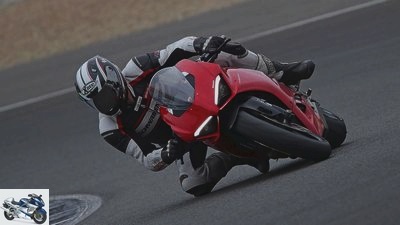
Ducati
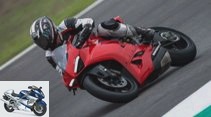

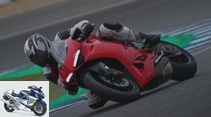
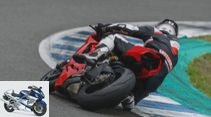
11 photos
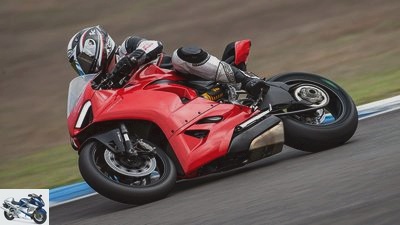
Ducati
1/11
The Panigale V2, the not so little sister of the V4 models with a displacement of 955 cm³, sticks to the Superquadro V2.
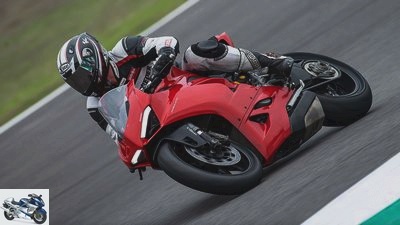
Ducati
2/11
It made its debut on the Jerez circuit.
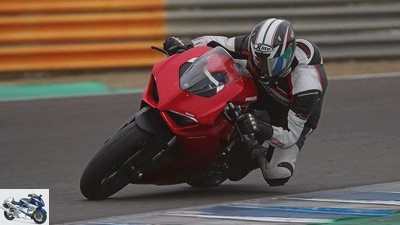
Ducati
3/11
The Panigale V2 impressively proves its helpfulness on the racetrack.
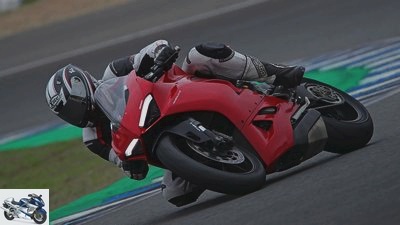
Ducati
4/11
We like the narrow waist and the easy-to-use geometry.
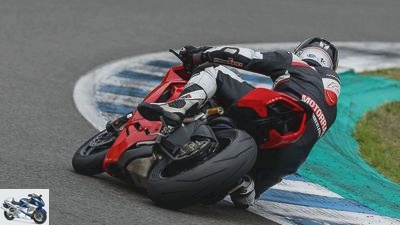
Ducati
5/11
The engine, homologated to Euro5 and thereby strengthened by five hp and two Nm, cracks strongly from around 6,000 rpm

Ducati
6/11
So energetic that at the beginning you often accidentally turn it into the limiter. Before that there is no noticeable decrease in performance.
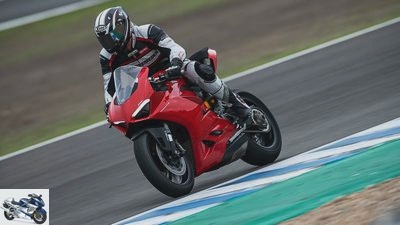
Ducati
7/11
The brake passes load tests with flying colors.
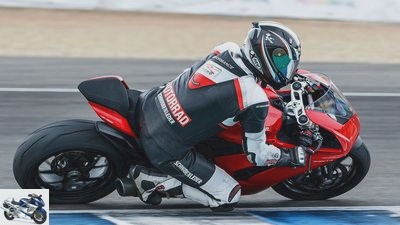
Ducati
8/11
The ABS on level two, which offers a cornering brake function but allows braking slides, did not noticeably intervene on the braking bumps.
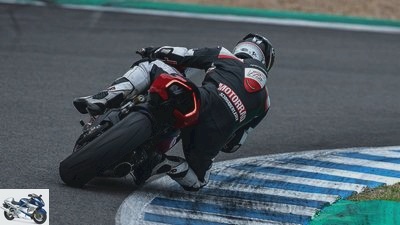
Ducati
9/11
Whether on a dry or wet track, the Panigale V2 is a lot of fun.
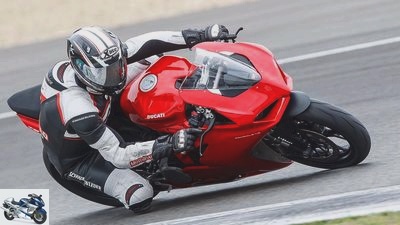
Ducati
10/11
The profound revision of the original Panigale 899/959 concept is already drawing our attention to a fascinating idea: …
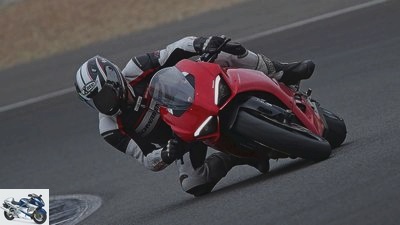
Ducati
11/11
… We are content with less and get more of it.
Ducati Panigale V2
V2 superbike in the driving report
The not so little sister of the V4 models with a displacement of 955 cm³ holds tight to the Superquadro-V2. It made its debut on the Jerez circuit.
D.he first laps are always the hardest. Especially on a route like the Circuito de Jerez, where you can find a lot of time, speed and fun with precisely driven lines, but after 19 years of absence, these lines first have to be worked out from the rough. A motorcycle like the Panigale V2 helps in such a situation.
She impressively proves her willingness to help in the second session in the transition from turn two, a very tight right-hand bend to the wider left-hand bend of turn three. It is important to accelerate vigorously out of the narrow two, but under no circumstances allow yourself to be carried too far to the left. At full acceleration, both the motorcycle and the rider have to jiggle to the left, and this works surprisingly well thanks to the V2’s narrow waist and easy-to-use geometry. Sometimes the front wheel snaps briefly into the air when swiveling through the zero position – again, nobody has photographed that – but the “little” Panigale leads precisely and safely to the apex of the left-hand bend and out again with even more violent acceleration. This maneuver is not that easy, but when it succeeds, it’s nice to cheer.
The V2 turns vigorously despite Euro 5
The fourth gear is due before the next wide left-hand bend, before entering the right-hand bend, which leads over a crest onto the downhill straight. A good place to feel the torque curve of the 955 V2. But unfortunately the traction control in level five of eight regulates the performance a little too defensively. Because accelerating downhill does not apply, the only touchstone is the home straight. There the engine, which is now homologated according to Euro5 and thereby strengthened by five hp and two Nm, starts to crack vigorously from around 6,000 rpm. So energetic that at the beginning you often accidentally turn it into the limiter. Before that there is no noticeable decrease in performance; probably the rated speed is pretty close to the limiter. What’s going on underneath? Not yet tested. This is not the place for pull-through measurements.
Ducati
More like load tests with the brake system. Twice per lap you have to brake down from the more or less twisted fifth gear to below 100 km / h. A test which the combination of 320 discs and Brembo M4 type brake calipers passes with flying colors. From tightening to releasing the lever, there is no slackening, no shift in the pressure point. The ABS on level two, which offers a cornering braking function, but allows braking slides, did not noticeably intervene on the braking bumps at the end of the home straight. For the time being, this setting is also recommended to experienced racer drivers.
Rain dilutes knowledge
Ducati
Why only until further notice? Simply because the optimization of the braking points or the fine-tuning of the lines came out just as little as the plan to set the traction control to level three for the next fifteen-minute section. All of this literally fell into the water – it began to rain, spraying softly at first, then violently in strong gusts of wind. The storm later gave way to the occasional drizzle, but the track never got dry for the rest of the day. So rain tires were popular. These offer an unbelievable amount of grip in the wet, but due to their special characteristics change the properties and perception of a motorcycle considerably.
For example, when braking into the first corner after the start and finish with the Pirelli Dragon Supercorsa in the dry, the fork appeared to be quite unyielding. It dipped in by a certain amount, but then gave the impression of hardening itself so much at the hydraulic end stop that it did not want to compress even when driving over the bumps already mentioned. This impression was completely gone with rain tires, although the Ducati technicians had not changed the fork setting. The soft carcass structure and the super-soft rubber compound did the suspension work that the super sport tires could not do in the dry due to their design for higher acceleration and braking forces and the fork due to their coordination. On the other hand, the rain tires ensured vigorous agitation in the steering when accelerating over the crest, which had not even occurred before. So this driving report is not a unit, but consists of two halves that were created under completely different conditions.
Conclusion
Whether on a dry or wet track, the Panigale V2 is a lot of fun. A test has to clarify how it drives on the country road. The profound revision of the original Panigale 899/959 concept is already drawing our attention to a fascinating idea: We are content with less and get more of it. Because who – please be completely honest – can claim to exhaust a 214 hp rocket so that it is really faster than the Panigale V2? I do not dare to say so.
Related articles
-
3C-Ducati 1199 Panigale R in the driving report
Porozzi 19th photos Porozzo 1/19 The 3C-Ducati 1199 Panigale R … Porozzo 2/19 Almost unspectacular r equal ig and without penetration che pushes the…
-
Ducati 899 Panigale in the driving report
Cervetti 17th photos Ducati 1/17 Even with the front wheel still braked and at high speed, the Ducati 899 Panigale hits the path precisely into the…
-
Driving report Ducati 996 R gingerbread This is exactly how everyone likes it: a delicious piece of cream with a lot of pepper in it. Ducati 996 R, the hottest ever …
-
Driving report Aprilia RSV mille R “Haga”, Ducati 998 S “Bostrom ??
Driving report Aprilia RSV mille R “Haga”, Ducati 998 S “Bostrom ?? Rare pop stars, sinfully expensive and hovering between art and kitsch: Aprilia and Ducati …
-
Ducati Multistrada 950 in the driving report
Ducati 25th photos Ducati 1/25 MOTORRAD editor-in-chief Michael Pfeiffer accompanied Ducati boss Claudio Domenicali on a first trip with the new…
-
Driving report Ducati Panigale V4 and V4 S
Ducati 47 photos Ducati 1/47 The Ducati Panigale V4 marks the beginning of a new era! Ducati 2/47 The new V4 engine offers a wide speed range, turns like…
-
Honda RC213V-S in the PS driving report
Honda 14th photos Honda 1/14 Honda made its announcements true and actually built a commercially available MotoGP machine for the road with the RC213V-S….
-
Ducati Monster 797 in the driving report
Ducati 24 photos Ducati 1/24 The new Monster 797 as an entry-level model in the Ducati’s naked bike family. Ducati 2/24 The engine is not unknown: it…
-
Ducati Multistrada 950 S in the driving report
Ducati Ducati Multistrada 950 S in the driving report lead by technology Ducati has significantly upgraded its all-round enduro sports tourer Multistrada…
-
Ducati Monster 1200 S in the driving report
Ducati 47 photos Ducati 1/47 Ducati 2/47 Ducati 3/47 Ducati 4/47 Ducati 5/47 Ducati 6/47 Ducati 7/47 Ducati 8/47 Ducati 9/47 Ducati 10/47 Ducati 11/47…